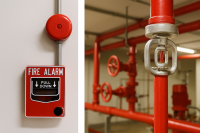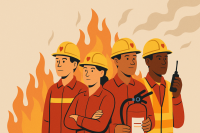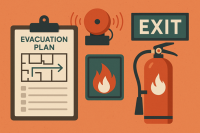
In the early morning hours of a quiet Monday, a small but thriving local business in the heart of a bustling Indonesian city faced what could have been a catastrophic disaster. Sparks from a short circuit in an aging fuse box ignited a smoldering fire within the walls of the facility. However, thanks to a comprehensive and proactive fire protection plan, what could have turned into a complete loss was instead controlled within minutes — saving not only property and inventory but also livelihoods, continuity, and reputation.
This is the story of how a small business, equipped with foresight and the right fire protection strategy, turned a potential tragedy into a powerful testament to the value of preparedness.
The Business at Risk
The business in question was a mid-sized printing and packaging company that had operated for over a decade. With more than 40 employees, the company handled large volumes of paper, ink, and flammable solvents — all elements that make a fire particularly dangerous. Although operations were smooth and employee morale was high, the owner, Mr. Aditya Santoso, had always been acutely aware of the risks involved in running such a facility.
“Paper burns fast. And when you’re working with flammable liquids, you can’t afford to be careless. I didn’t want to wait for something to go wrong before taking action,” he said in an interview.
Laying the Foundation: The Proactive Approach
Several years ago, Aditya partnered with a certified fire protection consultant to assess risks and design a comprehensive fire protection plan. The consultant emphasized three key pillars:
- Prevention
- Detection and Alert
- Response and Containment
Together, they implemented the following measures:
- Risk Assessment and Mitigation: An initial audit identified the most vulnerable areas — including outdated wiring, overloaded electrical panels, and insufficient ventilation near chemical storage. These were promptly upgraded.
- Early Detection Systems: Smoke detectors and heat sensors were installed throughout the facility, integrated into a smart fire alarm system with real-time alerts sent to both security personnel and the local fire department.
- Sprinkler Systems and Fire Extinguishers: A modern automatic sprinkler system was installed with zones tailored for specific risks. Employees were also trained to use Class A, B, and C fire extinguishers, strategically located in high-risk areas.
- Evacuation Drills and Employee Training: Staff underwent quarterly fire drills and received training in fire response protocol. Emergency exits were clearly marked and kept unobstructed at all times.
- Fireproof Storage and Digital Backups: Important business documents, contracts, and digital servers were either fireproofed or backed up in off-site cloud storage.
The Incident
On that fateful Monday morning, the fire began in the main control panel room. A faulty wire sparked and began burning the insulation within the wall.
But at 03:11 AM, the smoke detectors sensed the early signs of smoke. Within seconds, an alert was sent to the building’s security team and the local fire department via the integrated system.
Before the fire could spread to the adjoining stockroom full of paper rolls, the zoned sprinkler system activated in that specific area, dousing the flames directly at the source. Security staff, trained for such incidents, shut down the main power to prevent escalation. The fire department arrived in under 10 minutes to ensure the fire was fully extinguished and verify the building’s safety.
The Aftermath: Minimal Damage, Maximum Learning
Thanks to the rapid response triggered by the proactive fire protection plan, the fire was contained within one room. There were:
- No injuries
- No loss of inventory
- Less than IDR 30 million in structural damage, mostly limited to wiring and wall panels
- Zero downtime, as operations resumed later that same day
The insurance claim process was swift, aided by well-documented safety protocols and training logs. In fact, the insurer later reduced the company’s premium for demonstrating high-level preparedness and risk mitigation.
Lessons for Other Businesses
This story offers crucial lessons for other business owners, whether managing a small retail shop, a restaurant, or an industrial facility:
- Don’t Wait for a Fire to Act
Reactive fire protection often comes too late. Investing early in prevention and training saves lives, property, and money in the long run. - Get a Professional Assessment
Each facility has unique fire hazards. A professional fire safety audit can uncover hidden risks you might overlook. - Train Your People
Technology helps, but trained humans save the day. Staff who know what to do in the first few minutes of an emergency make all the difference. - Maintain Your Equipment
Fire alarms, sprinklers, and extinguishers must be regularly inspected and maintained to ensure they function when needed. - Integrate With Local Emergency Services
Establishing a direct communication protocol with local fire departments can cut down response time dramatically.
A Model for Fire Safety
Aditya’s company is now often cited in local safety seminars and SME workshops as a model of proactive fire risk management. Beyond saving a business, this experience underscored a deeper message: preparedness isn’t just a policy — it’s a culture.
“The fire could have ruined everything we built,” Aditya reflected. “Instead, it proved that when you prepare not for if, but for when, you protect not just assets, but people, jobs, and futures.”
In a time where small businesses face growing uncertainties, this story reminds us all that one of the most powerful investments a business can make isn’t in marketing, tech, or product — but in resilience and readiness.
Conclusion
Fire doesn’t discriminate, but it does reward those who prepare. Whether you’re a small startup or a long-established company, a proactive fire protection plan isn’t just a safety measure — it’s a strategic advantage. Let this local success story be your inspiration to take action before it’s too late.





Leave A Comment